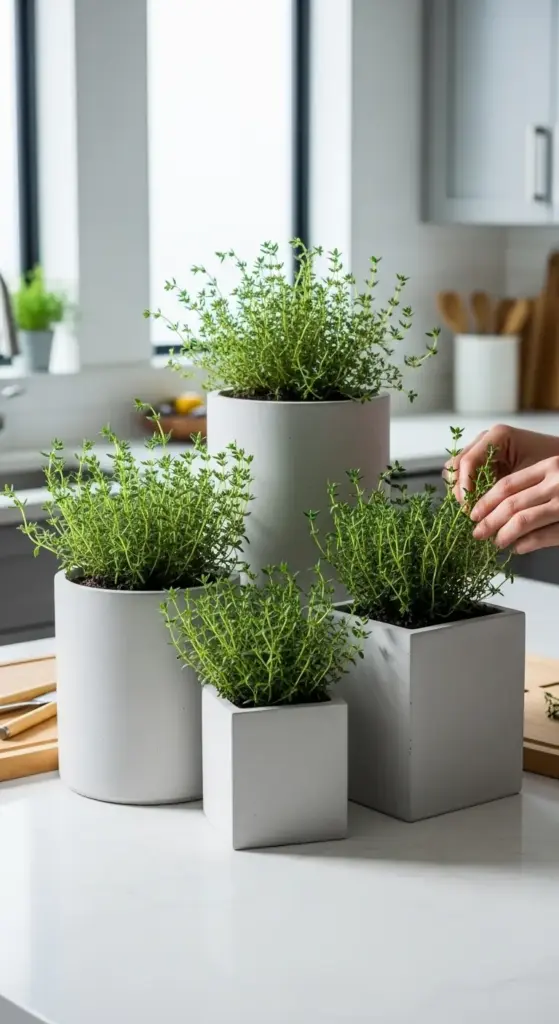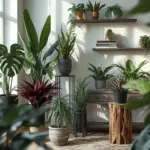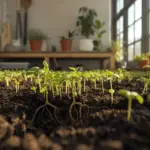3. Minimalist Concrete Vessels for Fresh Thyme

I stumbled into the concrete planter trend completely by accident when my ceramic pot cracked and I needed a quick replacement. My neighbor had this gorgeous concrete vessel sitting empty on her patio, and she let me borrow it for my struggling thyme plant.
That temporary fix became permanent real fast. The thyme absolutely exploded with growth in that concrete container – more than it ever had in fancy ceramic or plastic pots.
Why Restaurants Are Going Concrete Crazy
The high-end restaurant design world has embraced concrete planters for reasons that go way beyond just looking cool. I visited this trendy farm-to-table place in Seattle last year, and their entire herb wall was concrete vessels – it looked like modern art.
Concrete’s porous nature creates perfect drainage without being too aggressive about it. Thyme hates wet feet, but it also doesn’t want to dry out completely. Concrete hits that sweet spot naturally.
The thermal mass of concrete works similarly to marble but with a more industrial aesthetic. It keeps soil temperatures stable, which is crucial for thyme’s Mediterranean roots.
Restaurant designers love concrete because it’s practically indestructible. I’ve dropped my concrete planters more times than I care to admit, and they just get more character marks – no catastrophic breaks like ceramic.
DIY Concrete Projects That Actually Work
My first DIY concrete planter attempt was a total disaster. I used regular concrete mix from the hardware store and ended up with something that looked like a sidewalk chunk. Not cute.
The secret is using a concrete mix specifically designed for crafts – it’s finer and creates smoother surfaces. I get mine from craft stores, and it’s worth the extra cost for the finish quality.
Here’s my foolproof method: mix the concrete with water until it’s like thick brownie batter consistency. Use two containers – one larger for the outside mold, one smaller for the interior space.
Mold release spray is essential unless you want to destroy your containers getting the planter out. I learned this the hard way and lost a perfectly good mixing bowl to my concrete enthusiasm.
For drainage holes, I push drinking straws through the bottom before the concrete sets. Remove them after about 2 hours when the concrete is firm but not fully cured – timing is everything here.
Thyme Varieties for City Living
Urban apartment conditions can be brutal for herbs, but thyme is surprisingly adaptable if you choose the right varieties. I’ve killed my share of thyme plants by picking varieties that just couldn’t handle indoor life.
English thyme is my go-to for beginners because it’s practically bulletproof. The flavor is classic and works in everything from roasted vegetables to herb butter.
Lemon thyme brings this amazing citrusy twist that’s perfect for fish dishes and summer cocktails. It handles lower light conditions better than most thyme varieties, making it ideal for apartments with limited sun exposure.
Creeping thyme works beautifully in wider concrete vessels because it spreads naturally. The tiny purple flowers are adorable, and you get this living carpet effect that looks incredible in minimalist spaces.
French thyme has the most intense flavor but needs more consistent care. I only recommend it if you’re already comfortable with herb gardening basics.
Contemporary Kitchen Integration
Contemporary kitchen design and concrete planters are like peanut butter and jelly – they just work together perfectly. The key is treating your concrete vessels as functional art pieces, not just plant containers.
I group mine in odd numbers – three different sized concrete planters create visual interest without looking cluttered. The varying heights add dimension to counter spaces and make the whole setup feel intentional.
Color coordination matters more than you’d think. Pure white concrete looks amazing in kitchens with white or light gray cabinets, but charcoal concrete works better with darker color schemes.
Placement near natural materials like wood cutting boards or bamboo utensil holders creates this beautiful contrast between industrial and organic elements. The concrete softens when surrounded by warmer textures.
Year-Round Thyme Success
Seasonal care for thyme in concrete planters is different from outdoor gardening because the containers moderate temperature swings naturally. But there are still adjustments you need to make throughout the year.
Winter is when most people lose their thyme plants. The combination of dry indoor air and reduced sunlight can be deadly if you don’t adjust your care routine.
I move my concrete thyme planters closer to windows during winter months and reduce watering to about once a week. The concrete retains moisture longer in cooler temperatures, so overwatering becomes a real risk.
Spring pruning is crucial for year-round production. I cut back about half the plant in early spring to encourage fresh, tender growth. Thyme gets woody if you don’t stay on top of pruning.
Summer care is mostly about consistent moisture – I check the soil every other day by sticking my finger about an inch down. If it’s dry at that depth, it’s time to water.
The harvest timing affects how much your plant produces throughout the year. I harvest in the morning after dew evaporates but before the afternoon heat hits. This keeps the essential oils concentrated and encourages continued growth.
Ready to create stunning visual displays that’ll make your friends think you hired a professional designer? Click “next” to discover how glass terrariums can transform delicate cilantro into living art – plus the hydroponic secrets that guarantee fresh cilantro year-round!









GIPHY App Key not set. Please check settings